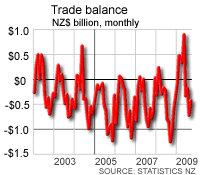Weak manufacturing output and a stalled construction sector drove New Zealand's GDP down 0.9% in the December quarter from the September quarter, which was in line with expectations and does not increase the pressure on the Reserve Bank to further cut the Official Cash Rate.
Meanwhile New Zealand's trade surplus surged in February to its best level in 8 years as a 14.2% fall in imports more than offset a 6.6% fall in exports. The imports fall was driven mostly by the lower cost of oil and a fall in merchandise imports as consumers bought fewer new cars and other non-essentials.
GDP in the December quarter contracted 1.9% from the December quarter a year ago, figures released by Statistics New Zealand (Stats NZ) show. December was the fourth consecutive quarter in which GDP contracted. Annual GDP growth in 2008 was 0.2% from 2007.
Economists had been expecting a 2% contraction in December quarter GDP from the same quarter a year ago and had expected a 1% fall in GDP for the quarter itself. Finance Minister Bill English had foreshadowed the release earlier this week, saying official data showed New Zealand's economy shrank by about 2% in 2008.
"The main drivers of the decline in economic activity in the latest quarter were the manufacturing and wholesale trade industries," Government Statistician Geoff Bascand said.
"Manufacturing activity declined 3.8% in the December 2008 quarter, with nearly all the manufacturing sub-industries recording decreases. The only manufacturing sub-industry to increase this quarter was food and beverage manufacturing," Bascand said.
"Value added in the wholesale trade industry declined 4.9%, the fourth consecutive quarterly decrease. Partly offsetting the declines within GDP was finance, insurance and business services, which was up 2.2% in the December 2008 quarter," he said.
JP Morgan economist Helen Kevans said they expected the ecomomy to expand again in the second half of 2009, and that the RBNZ had space to ease monetary policy further.
"We forecast that the economy will expand, albeit very modestly, in the second half of the year. The significant monetary and fiscal policy easing that has been (and will be) delivered should help New Zealand recover from this prolonged recession, with our forecast calling for annual GDP growth of 1.7% in 2010," Kevans said.
"The forecast recovery, though, will be milder than those experienced after previous recessions, where growth averaged 5%, mainly owing to the long process of household de-leveraging that still has to run its course," she said.
"Easing inflation pressures, sagging domestic house prices, and falling terms of trade give the RBNZ ample scope to ease policy further. We expect 25bp moves at the next two policy meetings in April and June, taking the OCR to 2.5%, which we believe will be the terminal rate in this easing cycle. The risks to this forecast remain skewed to the downside."
 Stats NZ also said New Zealand had a trade surplus in February of NZ$489 million (14.2% of exports) as imports shrank 14% year on year, while exports shrank by less than 7% from the same month a year ago. This was the first fall in exports since August 2007, Stats NZ said.
The monthly surplus was the biggest monthly surplus since May 2004 and the biggest surplus for a February since 2001. New Zealand last had a positive monthly trade balance in February last year.
Stats NZ also said New Zealand had a trade surplus in February of NZ$489 million (14.2% of exports) as imports shrank 14% year on year, while exports shrank by less than 7% from the same month a year ago. This was the first fall in exports since August 2007, Stats NZ said.
The monthly surplus was the biggest monthly surplus since May 2004 and the biggest surplus for a February since 2001. New Zealand last had a positive monthly trade balance in February last year.
NZ GDP contracted 0.9% in Dec qtr; Feb trade surplus biggest in 8 years
NZ GDP contracted 0.9% in Dec qtr; Feb trade surplus biggest in 8 years
27th Mar 09, 11:27am
by

We welcome your comments below. If you are not already registered, please register to comment
Remember we welcome robust, respectful and insightful debate. We don't welcome abusive or defamatory comments and will de-register those repeatedly making such comments. Our current comment policy is here.